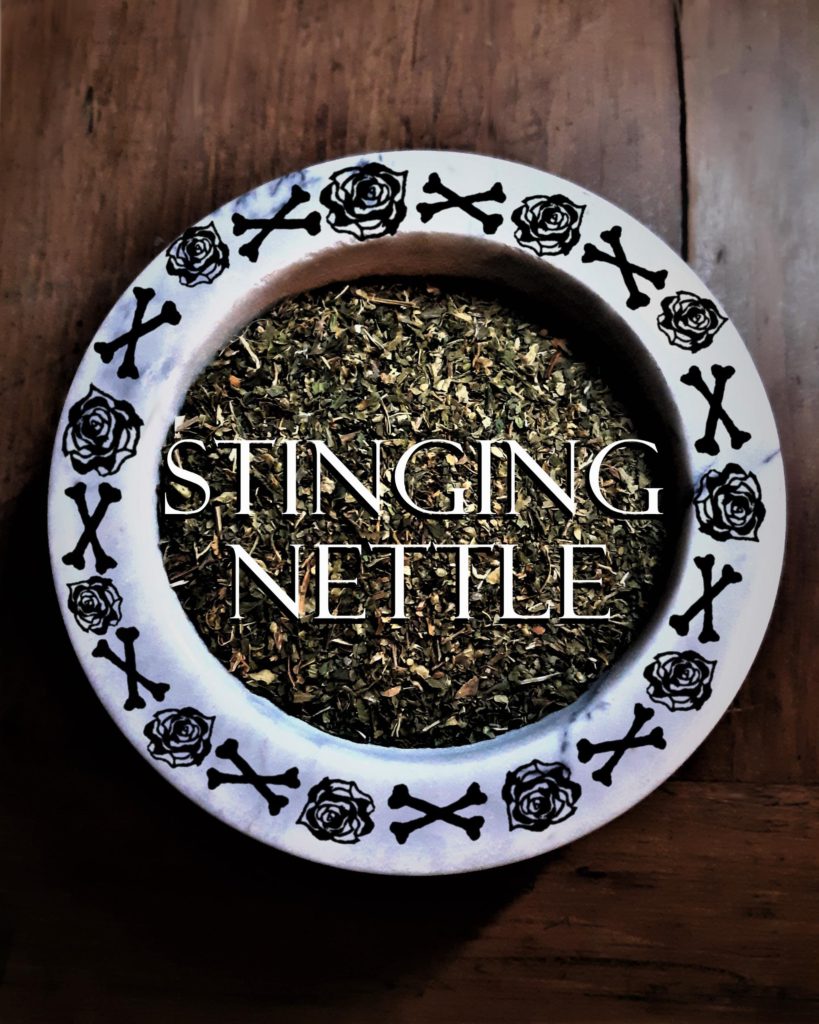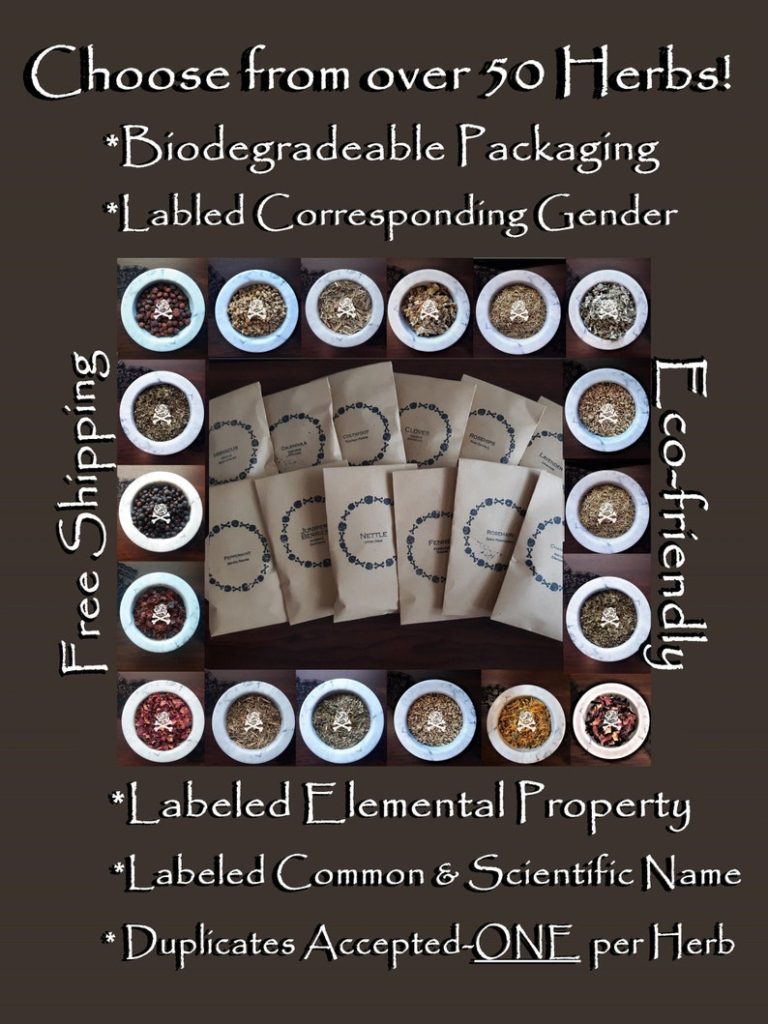
Ever had someone in your life that irritates the hell out of you, calls you out on your bs, and no matter what is ALWAYS around?
That’s basically what the essence of stinging nettle is like, but its intrusive traits are all out of love, protection, and growth.
This Th-HERBS-day, we honor stinging nettle, (Urtica dioica).
It’s a member of the nettle (Urticaceae) family and is a long-time favorite of hedgewitches and herbalists throughout history.
The word nettle comes from the Anglo-Saxon word for “needle” to describe the tiny hypodermic needle-like hairs covering its leaves.
You can equate grabbing a handful of nettles to a bee sting…but it’s not recommended to test this claim.
It’s been praised for having an astounding reach in nutritional benefits for both people and animals.
It has even been used in beauty as a lip plumper, though its effects don’t last very long.
Stinging nettle is a mighty power in almost all avenues of magick and health.
It can slap tough lessons on your path, force you to face painful truths, and won’t go away until you deal with it all.
Nevertheless, its intrusive unrelenting energy brings about overall change, growth, and enlightenment.
ARES MARS Greek God of War Statue Sculpture Figure Handmade Greece 6.69 inches

The History of Nettle
The Ninth-century book; On the Cultivation of Gardens, by Swiss monk Walafrid Strabo, is one of the oldest gardening books known.
In it, Strabo describes the nuisance of nettle’s tendency to take over gardens and his grief of digging them out.
It was considered an enemy of gardeners for thousands of years, but also praised for early medicinal development.
Despite its stinging nature, one of its earliest uses was for making cloth.
An excavation of a Bronze Age (3300 BCE to 1200 BCE) burial revealed that the body was wrapped in cloth made from nettle.
During WW1 Germans used close to 6 million pounds of nettle in place of cotton after supplies withered.
Nettle provided material that was used in twine and netting long ago for early fishermen.
In ancient times, nettles were used for a practice called urtication, where paralyzed limbs were slapped with stinging nettle.
It was believed that the irritants in the nettle combined with the slapping would bring feeling back into the limb.
Nettle drank as tea was and still is one of the most common ways to use the plant.
The herb loses its stinging characteristics after it has been boiled, and its tasty flavor provides overall health benefits.
On the Cultivation of Gardens Paperback

The Witchery in Stinging Nettle
Planting stinging nettle around the home is one way to utilize the protective powers of Mars.
Just be prepared to handle its everlasting expanding “armies” of plants because their roots toughen after wintering and they return with a force year after year.
Stinging nettle is blunt, tumultuous, catalyzing, disrupting, protective, and has everlasting energy.
Like the molten lava in the earth’s core, the pure fiery rage of Mars lies dormant in the far-reaching roots of this fierce herb.
Even its roots bleed a color of fire and have been useful for making yellow dyes.
When the season of Aries arrives, its unstoppable sprouts push through the soil like erupting volcanos.
It can be ruthless, and seemingly hopeless after many failed attempts to rid the garden of this persistent green warrior.
But as soon as you accept that there is no fighting its militia of stinging leaves, you can appreciate the benefits of its turbulent arrival.
The intrusive presence of stinging nettle is not in vain, nor a detriment to you and your garden, instead it brings nourishment and protection.
Stringing nettle brings peace and prosperity to the garden despite its abrupt presence.
It blesses the soil with nutrients as well as attracts predatory insects and animals that feed on the pests of other garden plants.
It relates perfectly to The Tower in the tarot, abrupt upheaval in its attempts to destroy your state of comfort so that change is forced and spiritual growth and prosperity result.
Raised Garden Bed Set Flower Vegetables Seeds Planter Kit Elevated Square Box

Stinging Nettle’s Energetic Properties
This list of stinging nettle’s properties is an extremely helpful guide to assist you in spell crafting and rituals.
The energy of the herb is heightened when planned carefully with corresponding days, seasons, zodiacs, etc.
Here are 18 energetic properties associated with stinging nettle:
1. Planet: Mars
2. Zodiac Sign: Aries
3. House: 1st and 8th
4. Element: Fire
5. Gender Energy: Masculine and Feminine
6. Chakra: Manipura/Solar Plexis (Yellow)
7. Archangel: Cameal
8. Deity: Ares (Greek), Thor (Norse), Laran (Etruscan)
9. Sabbat: Ostara
10. Season: Early Spring
11. Day: Tuesday
12. Body: Head, External Sex Organs, Muscular System, Face, Left Ear, Sense of Taste, Bladder
13. Rune: Fehu, Uruz
14. Numerology: 9
15. Fae: Salamander
16. Major Arcana: The Emperor, The Tower, Death
17. Minor Arcana: Wands
18. Cartomancy: Diamonds

Cultivating Nettle
Stinging nettle grows very easily.
You can cultivate it from seed or by division, though you might want to go the seed route if you don’t want to be stung.
Although, if you plan to grow from division, just be sure to wear gloves that protect both your hands and wrists.
Nettle likes moist soil, and it likes to grow near water banks in the wild.
It likes full sun, but part of the day should be in the shade, so planting it in an area that shadows near the late afternoon are ideal.
Keep in mind that nettle can be invasive once established.
It can easily take over the garden, so planting it in boxed-in areas would be a good idea to keep this from happening.
However, it can help keep pests away from other plants because it attracts predatory insects and that feed on them.
You may also find that nettle can be an excellent source of nitrogen for the soil.
According to Rodale’s Illustrated Encyclopedia of Herbs, “If you have a place on your property where nettles thrive, consider putting a garden there; nettles flourish in fertile soil.”
Some gardeners create a liquid fertilizer by creating a tea using nettle.
Take a bucketful of nettles, cover them with water, and let it brew for one to three weeks.
Then use the brew to water your plants to encourage faster growth and bloom production.
Happy Th-HERBS-day!
